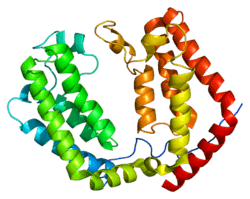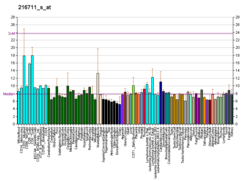TAF1
Transcription initiation factor TFIID subunit 1, also known as transcription initiation factor TFIID 250 kDa subunit (TAFII-250) or TBP-associated factor 250 kDa (p250), is a protein that in humans is encoded by the TAF1 gene.[5][6]
Function
Initiation of transcription by RNA polymerase II requires the activities of more than 70 polypeptides. The protein that coordinates these activities is the basal transcription factor TFIID, which binds to the core promoter to position the polymerase properly, serves as the scaffold for assembly of the remainder of the transcription complex, and acts as a channel for regulatory signals. TFIID is composed of the TATA-binding protein (TBP) and a group of evolutionarily conserved proteins known as TBP-associated factors or TAFs. TAFs may participate in basal transcription, serve as coactivators, function in promoter recognition or modify general transcription factors (GTFs) to facilitate complex assembly and transcription initiation. This gene encodes the largest subunit of TFIID. This subunit binds to core promoter sequences encompassing the transcription start site. It also binds to activators and other transcriptional regulators, and these interactions affect the rate of transcription initiation. This subunit contains two independent protein kinase domains at the N and C-terminals, but also possesses acetyltransferase activity and can act as a ubiquitin-activating/conjugating enzyme. Two transcripts encoding different isoforms have been identified for this gene.[5] Histones are often acetylated to open DNA for transcription. TAF1 contains two bromodomains, which each can bind one of two acetyllysine residues at position 5 and 12 in the H4 tail, to stabilize the TBP-TATA box complex.
Clinical significance
A mutation in TAF1 was identified that contributes to a phenotype with severe intellectual disability (ID), a characteristic intergluteal crease, and distinctive facial features, including a broad, upturned nose, sagging cheeks, downward sloping palpebral fissures, prominent periorbital ridges, deep-set eyes, relative hypertelorism, thin upper lip, a high-arched palate, prominent ears with thickened helices, and a pointed chin[7][8] This is a non-synonymous change in TAF1 that results in an isoleucine (hydrophobic) to threonine (polar) change on the 1337th amino acid residue in the protein (NP_001273003.1). Two other mutations were reported in TAF1 in two families with intellectual disability, although further clinical details were not reported.[9]
Interactions
TAF1 has been shown to interact with:
See also
References
- 1 2 3 GRCh38: Ensembl release 89: ENSG00000147133 - Ensembl, May 2017
- 1 2 3 GRCm38: Ensembl release 89: ENSMUSG00000031314 - Ensembl, May 2017
- ↑ "Human PubMed Reference:".
- ↑ "Mouse PubMed Reference:".
- 1 2 "Entrez Gene: TAF1 TAF1 RNA polymerase II, TATA box binding protein (TBP)-associated factor, 250kDa".
- ↑ Sekiguchi T, Yoshida MC, Sekiguchi M, Nishimoto T (April 1987). "Isolation of a human X chromosome-linked gene essential for progression from G1 to S phase of the cell cycle". Exp. Cell Res. 169 (2): 395–407. doi:10.1016/0014-4827(87)90200-X. PMID 3556424.
- ↑ He M, Person TN, Hebbring SJ, Heinzen E, Ye Z, Schrodi SJ, McPherson EW, Lin SM, Peissig PL, Brilliant MH, O'Rawe J, Robison RJ, Lyon GJ, Wang K (Jan 2015). "SeqHBase: a big data toolset for family based sequencing data analysis". Journal of Medical Genetics. 52: 282–8. doi:10.1136/jmedgenet-2014-102907. PMC 4382803. PMID 25587064.
- ↑ "A variant in TAF1 is associated with a new syndrome with severe intellectual disability and characteristic dysmorphic features". The American Journal of Human Genetics. 97: 922–932. doi:10.1016/j.ajhg.2015.11.005.
- ↑ Hu H, Haas SA, Chelly J, Van Esch H, Raynaud M, de Brouwer AP, Weinert S, Froyen G, Frints SG, Laumonnier F, Zemojtel T, Love MI, Richard H, Emde AK, Bienek M, Jensen C, Hambrock M, Fischer U, Langnick C, Feldkamp M, Wissink-Lindhout W, Lebrun N, Castelnau L, Rucci J, Montjean R, Dorseuil O, Billuart P, Stuhlmann T, Shaw M, Corbett MA, Gardner A, Willis-Owen S, Tan C, Friend KL, Belet S, van Roozendaal KE, Jimenez-Pocquet M, Moizard MP, Ronce N, Sun R, O'Keeffe S, Chenna R, van Bömmel A, Göke J, Hackett A, Field M, Christie L, Boyle J, Haan E, Nelson J, Turner G, Baynam G, Gillessen-Kaesbach G, Müller U, Steinberger D, Budny B, Badura-Stronka M, Latos-Bieleńska A, Ousager LB, Wieacker P, Rodríguez Criado G, Bondeson ML, Annerén G, Dufke A, Cohen M, Van Maldergem L, Vincent-Delorme C, Echenne B, Simon-Bouy B, Kleefstra T, Willemsen M, Fryns JP, Devriendt K, Ullmann R, Vingron M, Wrogemann K, Wienker TF, Tzschach A, van Bokhoven H, Gecz J, Jentsch TJ, Chen W, Ropers HH, Kalscheuer VM (Feb 2015). "X-exome sequencing of 405 unresolved families identifies seven novel intellectual disability genes". Molecular Psychiatry. 21: 133–48. doi:10.1038/mp.2014.193. PMID 25644381.
- ↑ Allende-Vega N, McKenzie L, Meek D (September 2008). "Transcription factor TAFII250 phosphorylates the acidic domain of Mdm2 through recruitment of protein kinase CK2". Mol. Cell. Biochem. 316 (1–2): 99–106. doi:10.1007/s11010-008-9816-3. PMID 18548200.
- ↑ Adnane J, Shao Z, Robbins PD (January 1999). "Cyclin D1 associates with the TBP-associated factor TAF(II)250 to regulate Sp1-mediated transcription". Oncogene. 18 (1): 239–47. doi:10.1038/sj.onc.1202297. PMID 9926939.
- 1 2 Siegert JL, Rushton JJ, Sellers WR, Kaelin WG, Robbins PD (November 2000). "Cyclin D1 suppresses retinoblastoma protein-mediated inhibition of TAFII250 kinase activity". Oncogene. 19 (50): 5703–11. doi:10.1038/sj.onc.1203966. PMID 11126356.
- 1 2 3 Siegert JL, Robbins PD (January 1999). "Rb inhibits the intrinsic kinase activity of TATA-binding protein-associated factor TAFII250". Mol. Cell. Biol. 19 (1): 846–54. PMC 83941. PMID 9858607.
- ↑ Dikstein R, Ruppert S, Tjian R (March 1996). "TAFII250 is a bipartite protein kinase that phosphorylates the base transcription factor RAP74". Cell. 84 (5): 781–90. doi:10.1016/s0092-8674(00)81055-7. PMID 8625415.
- ↑ Ruppert S, Tjian R (November 1995). "Human TAFII250 interacts with RAP74: implications for RNA polymerase II initiation". Genes Dev. 9 (22): 2747–55. doi:10.1101/gad.9.22.2747. PMID 7590250.
- ↑ Malik S, Guermah M, Roeder RG (March 1998). "A dynamic model for PC4 coactivator function in RNA polymerase II transcription". Proc. Natl. Acad. Sci. U.S.A. 95 (5): 2192–7. doi:10.1073/pnas.95.5.2192. PMC 19292. PMID 9482861.
- ↑ Shao Z, Ruppert S, Robbins PD (April 1995). "The retinoblastoma-susceptibility gene product binds directly to the human TATA-binding protein-associated factor TAFII250". Proc. Natl. Acad. Sci. U.S.A. 92 (8): 3115–9. doi:10.1073/pnas.92.8.3115. PMC 42115. PMID 7724524.
- ↑ Shao Z, Siegert JL, Ruppert S, Robbins PD (July 1997). "Rb interacts with TAF(II)250/TFIID through multiple domains". Oncogene. 15 (4): 385–92. doi:10.1038/sj.onc.1201204. PMID 9242374.
- ↑ Gegonne A, Weissman JD, Singer DS (October 2001). "TAFII55 binding to TAFII250 inhibits its acetyltransferase activity". Proc. Natl. Acad. Sci. U.S.A. 98 (22): 12432–7. doi:10.1073/pnas.211444798. PMC 60071. PMID 11592977.
- ↑ Bellorini M, Lee DK, Dantonel JC, Zemzoumi K, Roeder RG, Tora L, Mantovani R (June 1997). "CCAAT binding NF-Y-TBP interactions: NF-YB and NF-YC require short domains adjacent to their histone fold motifs for association with TBP basic residues". Nucleic Acids Res. 25 (11): 2174–81. doi:10.1093/nar/25.11.2174. PMC 146709. PMID 9153318.
- ↑ Ruppert S, Wang EH, Tjian R (March 1993). "Cloning and expression of human TAFII250: a TBP-associated factor implicated in cell-cycle regulation". Nature. 362 (6416): 175–9. doi:10.1038/362175a0. PMID 7680771.
- ↑ O'Brien T, Tjian R (May 1998). "Functional analysis of the human TAFII250 N-terminal kinase domain". Mol. Cell. 1 (6): 905–11. doi:10.1016/s1097-2765(00)80089-1. PMID 9660973.
- ↑ Lin CY, Tuan J, Scalia P, Bui T, Comai L (Dec 2002). "The cell cycle regulatory factor TAF1 stimulates ribosomal DNA transcription by binding to the activator UBF". Curr. Biol. 12 (24): 2142–6. doi:10.1016/s0960-9822(02)01389-1. PMID 12498690.
Further reading
- Wassarman DA, Sauer F (2001). "TAF(II)250: a transcription toolbox". J. Cell Sci. 114 (Pt 16): 2895–902. PMID 11686293.
- Ha I, Lane WS, Reinberg D (1991). "Cloning of a human gene encoding the general transcription initiation factor IIB". Nature. 352 (6337): 689–95. doi:10.1038/352689a0. PMID 1876184.
- Sekiguchi T, Nohiro Y, Nakamura Y, Hisamoto N, Nishimoto T (1991). "The human CCG1 gene, essential for progression of the G1 phase, encodes a 210-kilodalton nuclear DNA-binding protein". Mol. Cell. Biol. 11 (6): 3317–25. PMC 360184. PMID 2038334.
- Sekiguchi T, Miyata T, Nishimoto T (1988). "Molecular cloning of the cDNA of human X chromosomal gene (CCG1) which complements the temperature-sensitive G1 mutants, tsBN462 and ts13, of the BHK cell line". EMBO J. 7 (6): 1683–7. PMC 457153. PMID 3169001.
- Sekiguchi T, Yoshida MC, Sekiguchi M, Nishimoto T (1987). "Isolation of a human X chromosome-linked gene essential for progression from G1 to S phase of the cell cycle". Exp. Cell Res. 169 (2): 395–407. doi:10.1016/0014-4827(87)90200-X. PMID 3556424.
- Ruppert S, Tjian R (1995). "Human TAFII250 interacts with RAP74: implications for RNA polymerase II initiation". Genes Dev. 9 (22): 2747–55. doi:10.1101/gad.9.22.2747. PMID 7590250.
- Hisatake K, Ohta T, Takada R, Guermah M, Horikoshi M, Nakatani Y, Roeder RG (1995). "Evolutionary conservation of human TATA-binding-polypeptide-associated factors TAFII31 and TAFII80 and interactions of TAFII80 with other TAFs and with general transcription factors". Proc. Natl. Acad. Sci. U.S.A. 92 (18): 8195–9. doi:10.1073/pnas.92.18.8195. PMC 41123. PMID 7667268.
- Ruppert S, Wang EH, Tjian R (1993). "Cloning and expression of human TAFII250: a TBP-associated factor implicated in cell-cycle regulation". Nature. 362 (6416): 175–9. doi:10.1038/362175a0. PMID 7680771.
- Shao Z, Ruppert S, Robbins PD (1995). "The retinoblastoma-susceptibility gene product binds directly to the human TATA-binding protein-associated factor TAFII250". Proc. Natl. Acad. Sci. U.S.A. 92 (8): 3115–9. doi:10.1073/pnas.92.8.3115. PMC 42115. PMID 7724524.
- DeJong J, Bernstein R, Roeder RG (1995). "Human general transcription factor TFIIA: characterization of a cDNA encoding the small subunit and requirement for basal and activated transcription". Proc. Natl. Acad. Sci. U.S.A. 92 (8): 3313–7. doi:10.1073/pnas.92.8.3313. PMC 42156. PMID 7724559.
- Thut CJ, Chen JL, Klemm R, Tjian R (1995). "p53 transcriptional activation mediated by coactivators TAFII40 and TAFII60". Science. 267 (5194): 100–4. doi:10.1126/science.7809597. PMID 7809597.
- Zhou Q, Sharp PA (1995). "Novel mechanism and factor for regulation by HIV-1 Tat". EMBO J. 14 (2): 321–8. PMC 398086. PMID 7835343.
- Parada CA, Yoon JB, Roeder RG (1995). "A novel LBP-1-mediated restriction of HIV-1 transcription at the level of elongation in vitro". J. Biol. Chem. 270 (5): 2274–83. doi:10.1074/jbc.270.5.2274. PMID 7836461.
- Jacq X, Brou C, Lutz Y, Davidson I, Chambon P, Tora L (1994). "Human TAFII30 is present in a distinct TFIID complex and is required for transcriptional activation by the estrogen receptor". Cell. 79 (1): 107–17. doi:10.1016/0092-8674(94)90404-9. PMID 7923369.
- Ou SH, Garcia-Martínez LF, Paulssen EJ, Gaynor RB (1994). "Role of flanking E box motifs in human immunodeficiency virus type 1 TATA element function". J. Virol. 68 (11): 7188–99. PMC 237158. PMID 7933101.
- Sun X, Ma D, Sheldon M, Yeung K, Reinberg D (1994). "Reconstitution of human TFIIA activity from recombinant polypeptides: a role in TFIID-mediated transcription". Genes Dev. 8 (19): 2336–48. doi:10.1101/gad.8.19.2336. PMID 7958900.
- Metz R, Bannister AJ, Sutherland JA, Hagemeier C, O'Rourke EC, Cook A, Bravo R, Kouzarides T (1994). "c-Fos-induced activation of a TATA-box-containing promoter involves direct contact with TATA-box-binding protein". Mol. Cell. Biol. 14 (9): 6021–9. doi:10.1128/MCB.14.9.6021. PMC 359128. PMID 8065335.
- Kashanchi F, Piras G, Radonovich MF, Duvall JF, Fattaey A, Chiang CM, Roeder RG, Brady JN (1994). "Direct interaction of human TFIID with the HIV-1 transactivator tat". Nature. 367 (6460): 295–9. doi:10.1038/367295a0. PMID 8121496.
- Nakashima T, Sekiguchi T, Sunamoto H, Yura K, Tomoda S, Go M, Kere J, Schlessinger D, Nishimoto T (1994). "Structure of the human CCG1 gene: relationship between the exons/introns and functional domain/modules of the protein". Gene. 141 (2): 193–200. doi:10.1016/0378-1119(94)90570-3. PMID 8163188.
- Ma D, Watanabe H, Mermelstein F, Admon A, Oguri K, Sun X, Wada T, Imai T, Shiroya T, Reinberg D (1993). "Isolation of a cDNA encoding the largest subunit of TFIIA reveals functions important for activated transcription". Genes Dev. 7 (11): 2246–57. doi:10.1101/gad.7.11.2246. PMID 8224850.
External links
- FactorBook TAF1
- GeneReviews/NCBI/NIH/UW entry on X-Linked Dystonia-Parkinsonism
- http://biorxiv.org/content/early/2015/01/21/014050
This article incorporates text from the United States National Library of Medicine, which is in the public domain.






